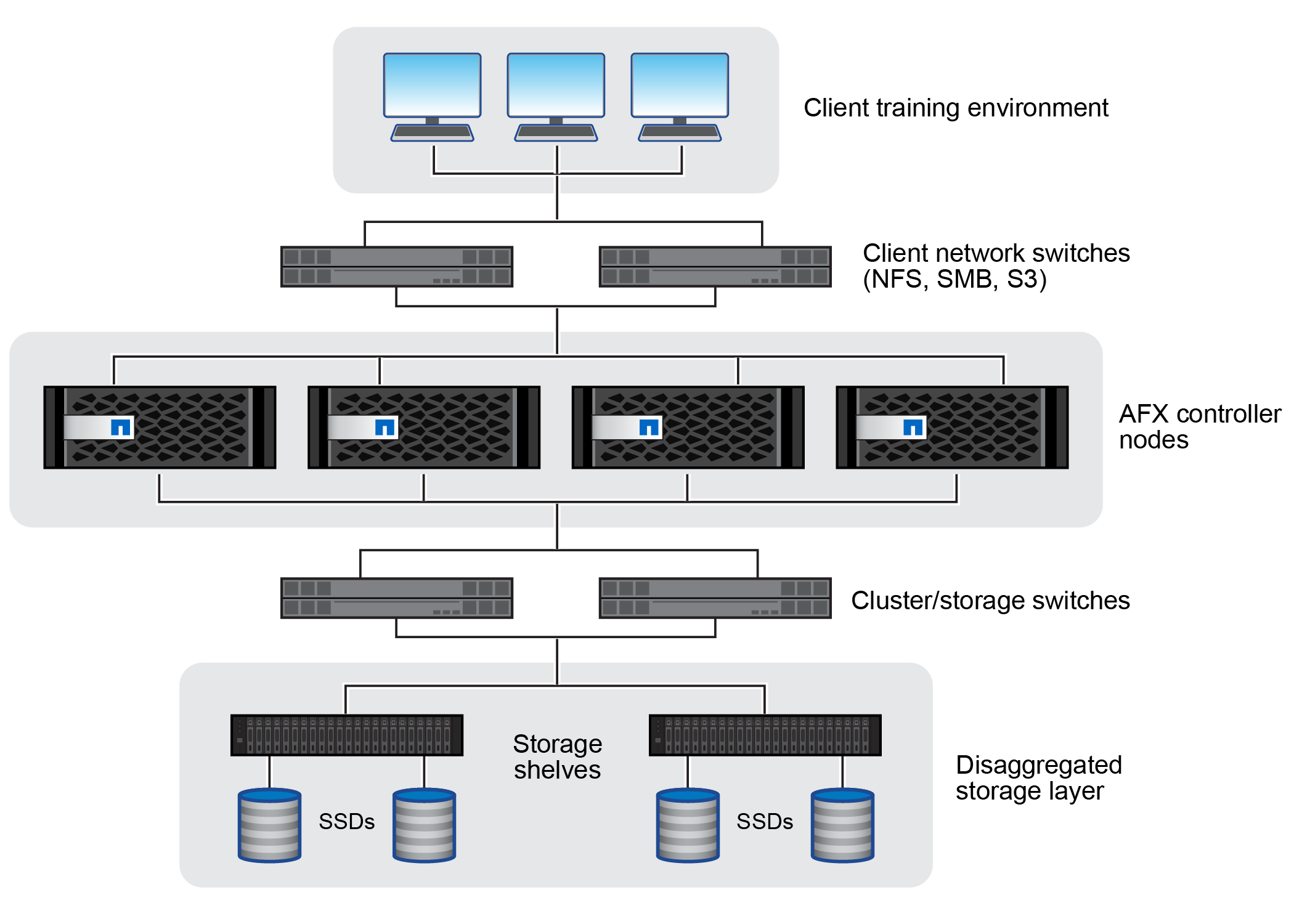Details of the AFX storage system architecture
 Suggest changes
Suggest changes


The AFX architecture is composed of several hardware and software components. These system components are organized in different categories.
Physical components
When first getting started with AFX, it's helpful to begin with a high-level view of the physical components as they're installed in your data center.
Controller nodes
AFX controller nodes run a specialized personality of the ONTAP software designed to support the requirements of the AFX environment. Clients access the nodes through multiple protocols, including NFS, SMB, and S3. Each node has a complete view of the storage, which it can access based on the client requests. The nodes are stateful with non‑volatile memory to persist critical state information and include additional enhancements specific to the target workloads.
Storage shelves and disks
AFX storage shelves use Non-volatile Memory Express over Fabrics (NVMe-oF) to connect high-density SSDs. The disks communicate over an ultra-low latency fabric using RDMA over Converged Ethernet (RoCE). The storage shelves, including the I/O modules, NICs, fans, and power supplies, are fully redundant with no single point of failure. Self-managed technology is used to administer and control all aspects of the RAID configuration and disk layout.
Cluster storage switch network
Redundant and high‑performance switches connect the AFX controller nodes with the storage shelves. Advanced protocols are used to optimize performance. The design is based on VLAN tagging with multiple network paths, as well as tech‑refresh configurations, to ensure continuous operation and ease of upgrade.
Client training environment
The client training environment is a lab environment with customer-provided hardware, such as GPU clusters and AI workstations. It's typically designed to support model training, inference, and other AI/ML related work. Clients access AFX using industry standard protocols such as NFS, SMB, and S3.
Client network
This internal network connects the client training environment to the AFX storage cluster. The network is provided and managed by the customer although NetApp expects to offer field recommendations for requirements and design.
Logical components
There are several logical components included with AFX. They are implemented in software along with the physical components of the cluster. The logical components enforce a structure that determines the use and configuration of the AFX systems.
Common storage pool
The Storage Availability Zone (SAZ) is a common pool of storage for the entire cluster. It's a collection of disks in the storage shelves that all the controller nodes have read and write access to. The SAZ offers a provisioning model with no fixed restrictions regarding which storage shelves can be used by the nodes; volume placement across the nodes is automatically handled by ONTAP. Customers can view free space and storage usage as properties of the entire AFX cluster.
FlexVolumes, FlexGroups, and buckets
FlexVolumes, FlexGroups, and S3 buckets are the data containers exposed to the AFX administrators based on the client access protocols. They operate identically to Unified ONTAP. These scalable containers are designed to abstract away many of the complex internal storage details, such as data placement and capacity balancing.
Data layout and access
The data layout and access is tuned for seamless access and efficient utilization of the GPUs. This plays a critical role in eliminating bottlenecks and maintaining consistent performance.
SVMs and multi-tenancy
AFX provides a tenant model that builds on the SVM model available with AFF and FAS systems. The AFX tenant model is the same as Unified ONTAP but has been streamlined for simplified administration in a NAS and S3 object environment. For example, configuration options for SAN as well as aggregates and RAID groups have been removed.
AFX cluster deployment
The following figure illustrates a typical AFX cluster deployment. The AFX cluster includes controller nodes which are decoupled from the storage shelves and connected through a shared internal network. Outside the AFX cluster boundary, clients access the cluster through a separate client network.



